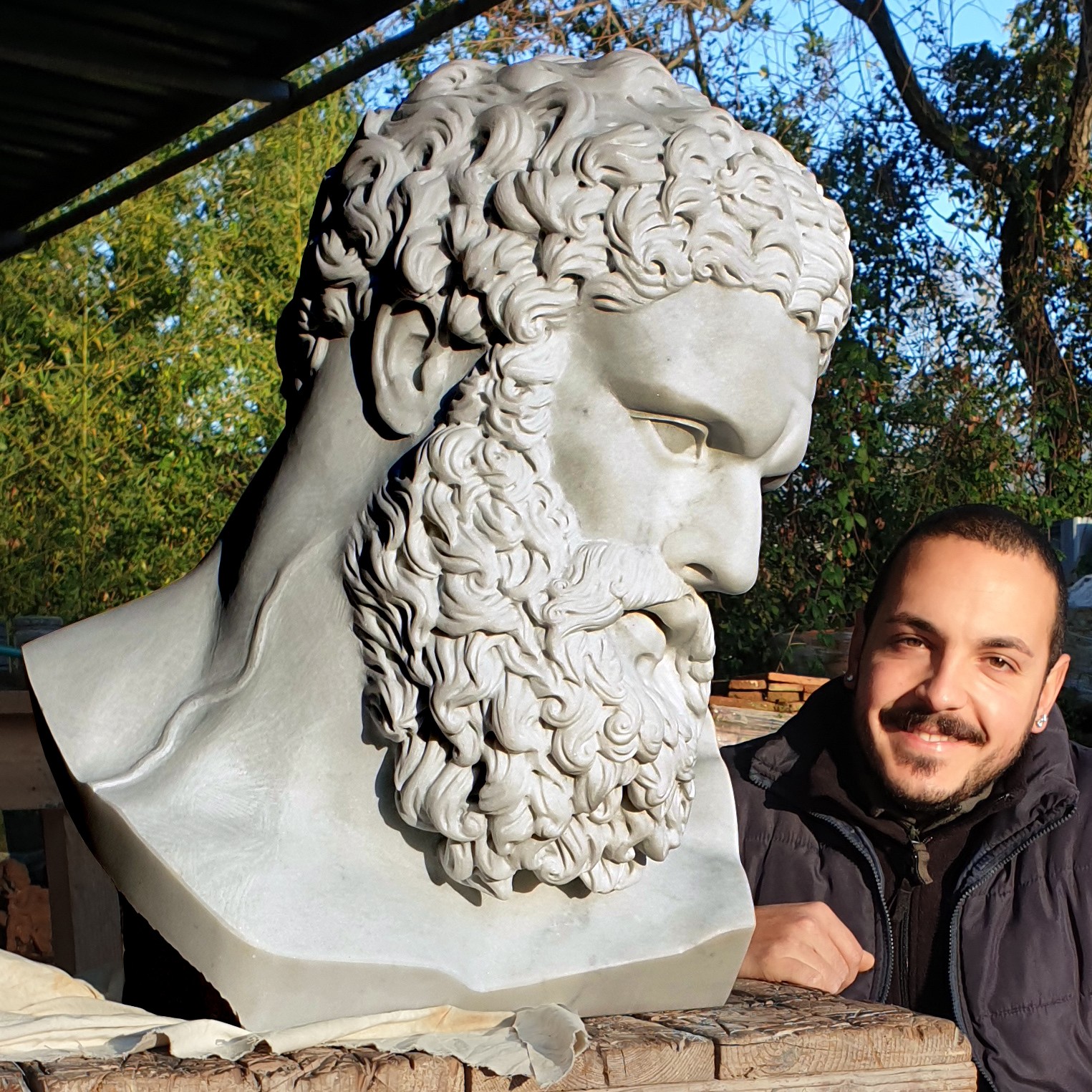














































Code art.: 13518
Price: 32.000,00 €
Stock availability: 1
The Farnese Hercules (Italian: Ercole Farnese) is an ancient statue of Hercules, probably an enlarged copy made in the early third century AD and signed by Glykon, who is otherwise unknown; the name is Greek but he may have worked in Rome. Like many other Ancient Roman sculptures it is a copy or version of a much older Greek original that was well known, in this case a bronze by Lysippos (or one of his circle) that would have been made in the fourth century BC. The enlarged copy was made for the Baths of Caracalla in Rome (dedicated in 216 AD), where the statue was recovered in 1546, and is now in the Museo Archeologico Nazionale in Naples. The heroically-scaled Hercules is one of the most famous sculptures of antiquity, and has fixed the image of the mythic hero in the European imagination.
The Farnese Hercules is a massive marble statue, following a lost original cast in bronze through a method called lost wax casting. It depicts a muscular, yet weary, Hercules leaning on his club, which has the skin of the Nemean lion draped over it. In myths about Heracles, killing the lion was his first task. He has just performed one of the last of The Twelve Labours, which is suggested by the apples of the Hesperides he holds behind his back.
The type was well known in antiquity, and among many other versions a Hellenistic or Roman bronze reduction, found at Foligno is in the Musée du Louvre. A small Roman marble copy can be seen in the Museum of the Ancient Agora, Athens ).
The rediscovered statue quickly made its way into the collection of Cardinal Alessandro Farnese, grandson of Pope Paul III. Alessandro Farnese was well placed to form one of the greatest collections of classical sculpture that has been assembled since Antiquity. It stood for generations in its own room at Palazzo Farnese, Rome, where the statue was surrounded by frescoed depictions of the hero's mythical feats that were created by Annibale Carracci and his studio, executed in the 1590s. The Farnese statue was moved to Naples in 1787 with most of the Farnese Collection and is now displayed in the Museo Archeologico Nazionale there.
The sculpture has been reassembled and restored by degrees. According to a letter of Guglielmo della Porta, the head had been recovered separately, from a well in Trastevere, and was bought for Farnese through the agency of della Porta, whose legs made to complete the figure were so well-regarded that when the original legs were recovered from ongoing excavations in the Baths of Caracalla, della Porta's were retained, on Michelangelo's advice, in part to demonstrate that modern sculptors could bear direct comparison with the ancients. The original legs, from the Borghese collection, were not reunited with the sculpture until 1787. Goethe, in his Italian Journey, recounts his differing impressions upon seeing the Hercules with each set of legs, however, marvelling at the clear superiority of the original ones.
Hercules is caught in a rare moment of repose. Leaning on his knobby club which is draped with the pelt of the Nemean Lion, he holds the apples of the Hesperides, but conceals them behind his back cradled in his right hand. Many engravings and woodcuts spread the fame of the Farnese's Hercules. By 1562 the find was already included in the set of engravings for Speculum Romanae Magnificentiae ("Mirror of Rome's Magnificence") and connoisseurs, artists, and tourists gaped at the original, which stood in the courtyard of the Palazzo Farnese, protected under the arcade. In 1590–91, during his trip to Rome, Hendrik Goltzius sketched the statue in the palazzo courtyard. Later (in 1591) Goltzius recorded the less-common rear view, in a bravura engraving (illustration, right), which emphasizes the already exaggerated muscular form with swelling and tapering lines that flow over the contours. The young Rubens made quick sketches of the planes and massing of the statue of Hercules. Before photography, prints were the only way to put the image into many hands.
The Farnese Hercules, engraved by Hendrick Goltzius, 1591, two onlookers give scale
The sculpture was admired from the start, reservations about its exaggerated musculature only surfacing in the later eighteenth century. Napoleon remarked to Antonio Canova that its omission from the museum he accumulated in Paris was the most important gap in the collection. More than once, the sculpture was crated and made ready for shipment to Paris before the Napoleonic regime fled Naples.
| Width: | 20.47 |
| Height: | 25.98 |
| Depth: | 15.75 |
| Weight: | 396.83 |
| Manufacturing: | Recuperando |
| Material: | Marmo bianco di Carrara |